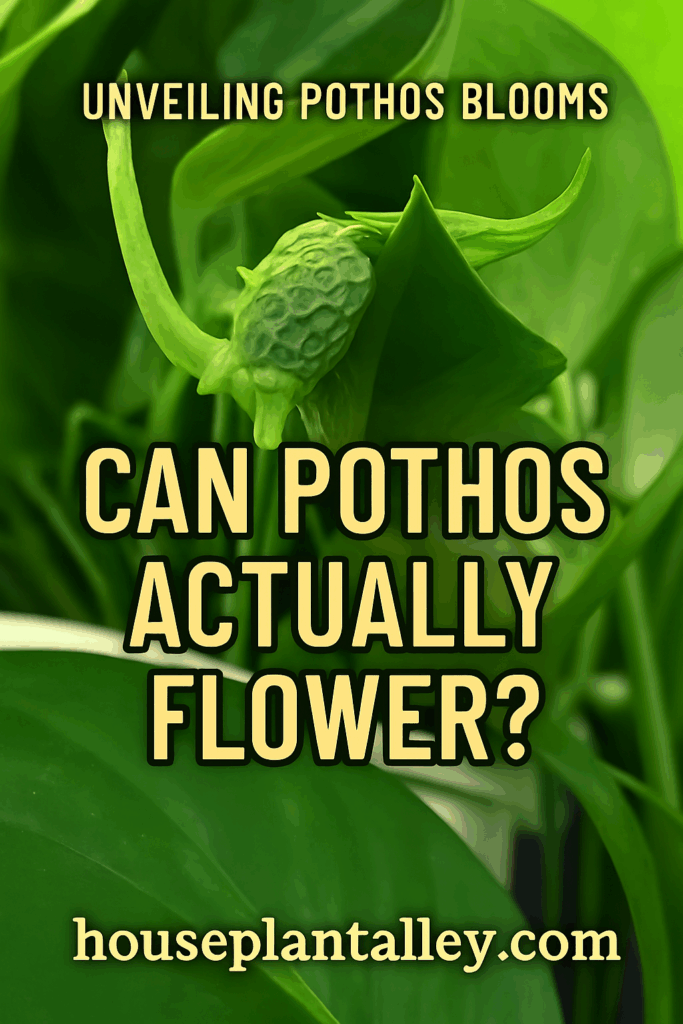Pothos plants hold a fascinating secret that most indoor gardeners never discover: their ability to produce flowers. While these common houseplants typically remain in their juvenile form, displaying only their characteristic heart-shaped leaves, wild pothos actually develop creamy-white blooms under specific conditions. “The key to revealing a pothos’ flowering potential lies in recreating its natural tropical environment,” explains botanist Dr. Sarah Chen. The journey from standard houseplant to flowering marvel requires understanding several critical factors.

Contents
While most indoor pothos owners never witness their plants blooming, these tropical vines possess remarkable flowering capabilities in their natural habitat. In their wild growth environments, pothos can develop massive vines stretching over 65 feet long, with leaves spanning up to 30 inches wide.
These mature specimens produce striking creamy, spade-shaped flowers followed by conical seed heads when conditions are ideal. The change occurs only in their natural habitat, where consistent temperatures above 70°F, high humidity, and proper light exposure support the shift from juvenile to reproductive phases. This flowering process showcases the true potential of these adaptable plants.
Why Your Indoor Pothos Won’t Bloom
Although many indoor gardeners dream of seeing their pothos produce flowers, these tropical vines rarely reach the maturity needed for blooming in household conditions. The primary reason is that indoor conditions keep pothos plants in their juvenile growth phase indefinitely.
Unlike their wild counterparts that can grow over 65 feet long, indoor pothos lack the essential flowering triggers found in their native habitat. These include consistent temperatures above 70°F, high humidity levels, and sufficient space for extensive growth. Without these specific environmental conditions, pothos will continue producing foliage but remain unable to shift into their reproductive phase.
Creating Optimal Conditions for Pothos Flowering
Creating ideal conditions for pothos flowering requires a careful combination of environmental factors that mirror their native tropical habitat. While indoor flowering is rare, outdoor or greenhouse environments provide the best chances for success.
Key requirements include:
- Temperatures consistently above 70°F year-round
- High humidity levels (60-80%)
- Fast-draining tropical soil enriched with peat moss
- Protection from direct sunlight
- USDA zones 10-12 for perennial growth
Flowering triggers often depend on:
- Mature growth phase achievement
- Proper humidity through regular misting
- Deep watering cycles mimicking monsoon patterns
- Greenhouse or outdoor placement in tropical climates
From Juvenile to Mature: Understanding Pothos Growth Phases
Pothos plants undergo distinct developmental stages as they grow from small indoor specimens into mature tropical vines. In their juvenile phase, these plants display heart-shaped leaves with smooth edges and grow primarily through vegetative reproduction.
As pothos mature in their natural habitat, dramatic changes occur. Mature features include massive leaves reaching up to 30 inches wide with distinctive splits, similar to monstera plants. The vines can extend beyond 65 feet, developing aerial roots and the potential for flowering.
Indoor pothos typically remain in their juvenile stage indefinitely, maintaining smaller leaves and vegetative growth patterns unless exposed to tropical outdoor conditions.
Essential Care Tips to Support Pothos Development
While indoor pothos rarely achieve the dramatic growth seen in tropical environments, proper care techniques can maximize their development and health. Essential soil amendments like peat moss and vermiculite create the fast-draining conditions these plants need to thrive.
Watering techniques should mirror natural tropical patterns. “Deep watering followed by periods of moderate soil drying prevents root issues while promoting robust growth,” explains botanist Dr. Sarah Chen. Allow the top 2-6 inches of soil to dry between waterings.
Maintain temperatures between 70-85°F and provide moderate humidity through regular misting or a humidifier for ideal development.
